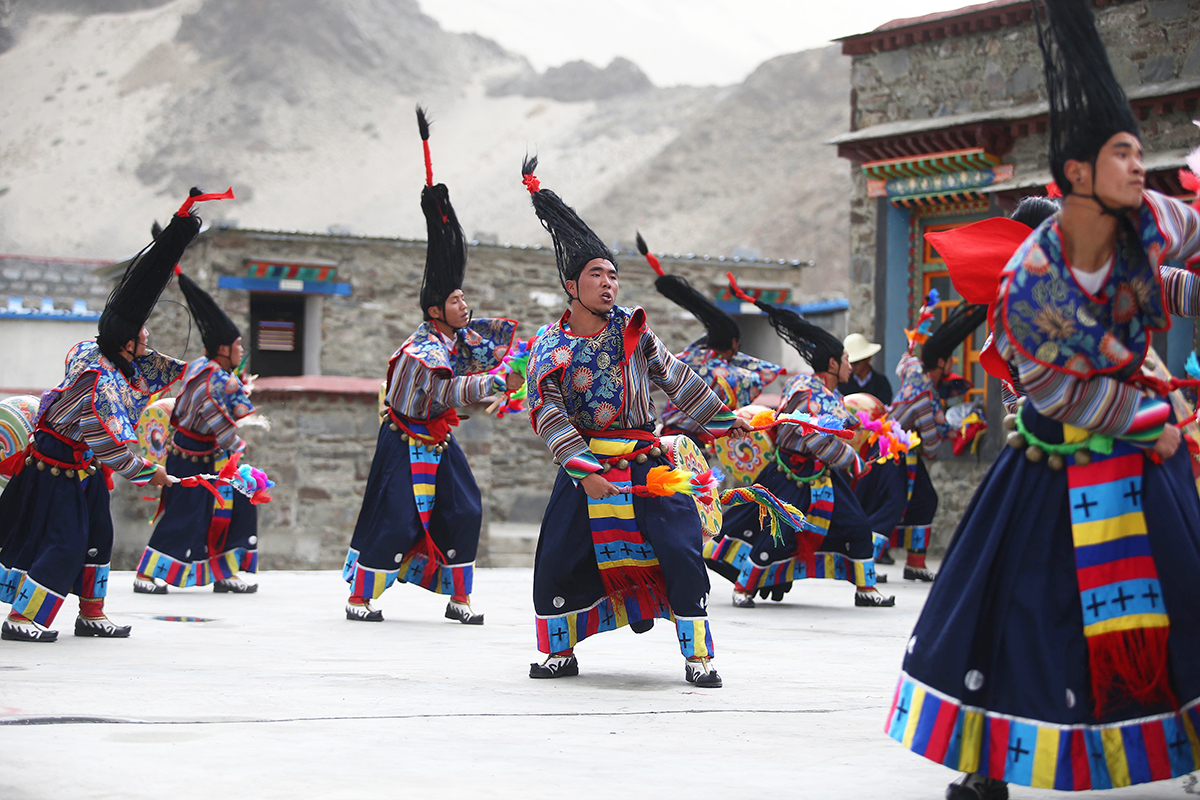
Open air operas, joyful dances, and hearty folk songs form just a small part of the rich tapestry that is traditional Tibetan performance. The most iconic of these arts is arguably the Tibetan opera, which is widely regarded as one of the finest opera forms in China. In true bucolic fashion, it is performed outside without a curtain or stage, relying entirely on the natural and effortless talent of its practitioners. The themes of Tibetan opera derive from a myriad of sources, from solemn Buddhist scripture and bold historical epics to grand legends and mystical folk tales. That being said, the origins of Tibetan opera itself were out of purely practical needs!
It is believed that, during the 14th century, an eminent Buddhist monk named Thangtong Gyalpo had planned to build a number of bridges, which would enable people to easily cross all of the major rivers in Tibet. However, he simply couldn’t afford to embark on this noble project without funding. With the help of seven sisters, he organised the first ever performance of Tibetan opera to raise funds. Some of the bridges he masterminded are still in use today, but by far his greatest legacy is the 700-year-old tradition of Tibetan opera. In short, this talented engineer bridged a gap between the past and the present!
Nowadays performances of Tibetan opera continue to be held, particularly on special occasions such as the Shoton Festival. The performers often wear colourful masks, which are used to identify certain character types. For example, dark red indicates a king; light red denotes a minister; yellow indicates the character is a Buddhist deity or monk; blue masks are for hunters; female characters wear green; ordinary male characters wear white; black signifies a villain; and a half white, half black mask symbolises a double-dealer. If only it were quite so simple in real life!
Before the performance can begin, the open air “stage” must be blessed and purified. A narrator will sing a summary of the story, and then the performance will start. Talk about plot spoilers! In the absence of realistic settings and props, it is up to the narrator to stimulate the audience’s imagination as he describes each scene. Once the performance is finished, another ritual blessing is conducted where a statue of Thangthong Gyalpo is honoured and presented with a hada by the performers. The plays vary vastly in length, with the shorter ones lasting several hours and the long ones taking upwards of two to three days to complete! Unlike other forms of Chinese opera, which employ diverse orchestras, Tibetan opera is usually only accompanied by drums and cymbals.
While Tibetan opera requires a degree of organisation and skill to perform, Tibetan circle dancing is popular in the countryside thanks to its simple, rural charm. A group of people arrange themselves in a circle and hold hands, with the circle itself being split into two teams. One team sings the song, while the other team joins in at the chorus, with both teams stamping on the ground in time with the rhythm. Normally this type of dance will take place in open ground or farming ground on the edge of villages and the songs are easy to remember, so many people can take part. During festival occasions, people have been known to dance from morning until night!

Other popular dance styles include Duixie or Tibetan tap dance and Zhuoxie or Tibetan drum dance. The Tibetan tap dance is marked by its quick and fancy footwork, with performers deftly changing their movements after every third step. The Tibetan drum dance is typically performed by men, who wear vibrantly coloured traditional clothes and a string of small bells tied around one ankle. A flat leather drum is attached to their hip via two strips of silk, one tied to their thigh and the other around their waist. Using a pair of small hammers, the performers rap the drum while dancing vigorously. As the rhythm builds and the performance continues, the drummers will start singing and eventually perform some acrobatic feats, which are sure to send the crowd into a frenzy of excitement.
While these styles of dance can be performed by anyone, the spectacular Cham dance is exclusively performed by Buddhist monks. Cham dances are considered to be a form of meditation and also a way to appease the gods. The performers dress in elaborate costumes, complete with strange face masks, and attempt to re-enact the behaviour, attitudes, and gestures of Buddhist deities in order to offer moral instruction to all those watching the performance. With their lively steps and fantastical costumes, Cham dancers truly are the lords of the dance!